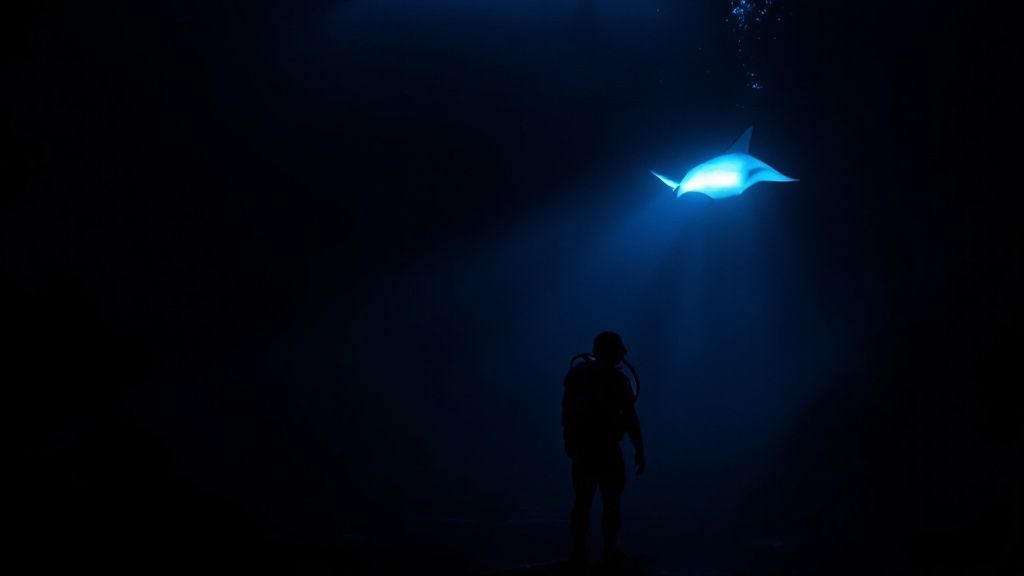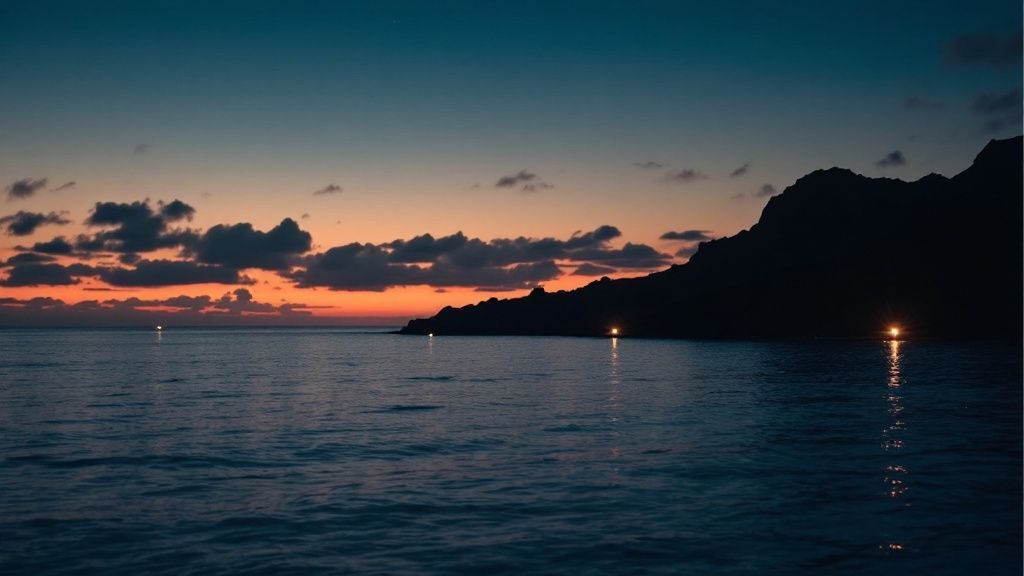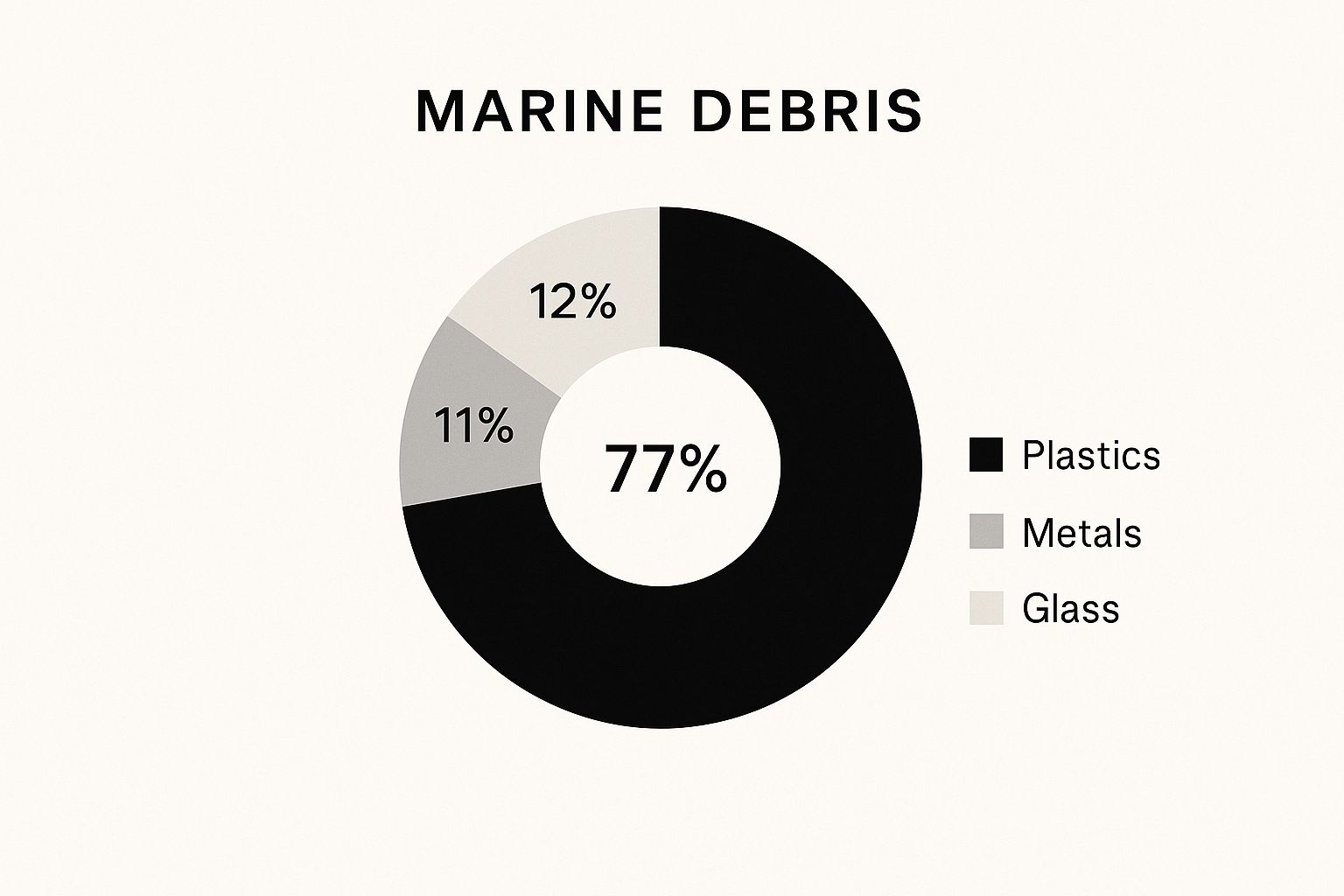Why Manta Dive Kona Captivates Underwater Enthusiasts
Manta ray night dives off the Kona coast are a truly unique experience, drawing divers and snorkelers from all corners of the globe. This isn't just another dive; it's an opportunity to witness these gentle giants up close in their natural environment. But what exactly makes the manta dive Kona experience so captivating for underwater enthusiasts?
The Kona Coast: A Manta Ray Haven
The Kona Coast presents a unique combination of factors that create the perfect environment for manta ray encounters. The volcanic slopes of the island give rise to deep, nutrient-rich waters near the shore. These nutrients, in turn, support a thriving plankton population, the manta ray's primary food source.
The calm, sheltered bays along the coast provide protection from strong currents and predators. This offers a safe and peaceful haven for these graceful creatures. The specialized lighting techniques employed by dive operators have also enhanced nighttime viewing, further attracting plankton and drawing the mantas closer to the surface.
Predictable Feeding Patterns and High Sighting Rates
The predictability of the manta rays' feeding habits makes Kona one of the most reliable places worldwide to witness these magnificent creatures. This predictability combined with excellent viewing conditions and a careful balance between tourism accessibility and marine conservation results in a remarkable 90% success rate for manta ray encounters. This makes the manta dive Kona experience Hawaii's most consistent wildlife experience.
Manta ray night dives off the Kona Coast have become one of the world's premier wildlife tourism attractions, drawing approximately 80,000 snorkelers and divers every year. These tours offer a rare glimpse of large manta rays, which boast an average wingspan exceeding 12 feet.
The dives typically last between 45 to 60 minutes and have incredibly high sighting rates. According to local dive operators, manta rays are seen on about 85% to 90% of dives, with some nights reaching probabilities as high as 95%, thanks to a local manta population estimated at over 450 individuals. Find more detailed statistics here. For a firsthand experience, consider a Manta Ray Snorkel Kona tour.
A Unique Underwater Phenomenon
Kona boasts a resident population of over 450 identifiable mantas, creating an underwater spectacle unlike anywhere else in the world. Why you should go on a manta ray dive in Kona. Experienced dive masters can even recognize individual mantas by their unique belly patterns, adding a personal touch to each encounter.
This intimate knowledge of the local manta population contributes significantly to ongoing research and conservation efforts. This makes manta dive Kona not only an unforgettable experience but also a sustainable and educational one.

To better understand the remarkable nature of this experience, let's take a look at some key statistics. The following table highlights what makes Kona such a special destination for manta ray encounters.
Manta Dive Kona: By The Numbers
| Statistic | Value | Significance |
|---|---|---|
| Average Manta Ray Wingspan | >12 feet | Demonstrates the impressive size of these gentle giants |
| Local Manta Ray Population | >450 individuals | Indicates a thriving, healthy population |
| Dive Duration | 45-60 minutes | Provides ample time for observation and interaction |
| Sighting Rate | 85-95% | Highlights the exceptional reliability of manta ray encounters in Kona |
| Annual Visitors | 80,000 | Shows the popularity and global appeal of this unique experience |
These numbers clearly demonstrate why Kona is a world-renowned hotspot for manta ray dives, offering an unparalleled opportunity to connect with these incredible creatures.
The Science Behind Kona's Magnificent Manta Encounters
A manta dive in Kona, Hawaii, is more than just an exciting tourist activity; it's a chance to participate in valuable research. This unique blend of tourism and science has resulted in one of the most comprehensive manta ray research programs in the world. This means every dive contributes important data, helping us better understand these gentle giants.
Unveiling Manta Mysteries Through Research
Marine biologists actively study Kona's manta ray population. Each encounter adds to a growing database of individual manta identification, behavior, and population health. For instance, researchers track unique belly patterns, similar to fingerprints, to monitor individual mantas over decades. This careful tracking has uncovered surprising information about their lifespan, social structures, and feeding habits.
Data-Driven Insights Into Manta Behavior
This research has revealed fascinating facts about manta ray life. We now know some mantas demonstrate strong site fidelity, coming back to the same feeding spots every night. Researchers have also discovered complex social interactions among mantas, suggesting a greater intelligence than previously believed. This expanding knowledge enhances the dive experience and is vital to conservation efforts. Between 2009 and 2014, detailed statistical records of manta ray sightings were kept during night dives along the Kona Coast. This research involved monitoring individual mantas’ appearances, health, and movement between two popular dive sites, "Manta Village" and "Manta Heaven." Data collection occurred nightly, six to seven times a week, by professional divers and underwater videographers. These long-term records help scientists and advocates understand manta ray travel within their habitat and predict peak sighting periods. Find more detailed statistics here. You might also be interested in: What is a manta ray night dive?.
The Power of Citizen Science
Witnessing manta rays at night is especially captivating. Manta Ray Night Snorkel in Hawaii provides a truly memorable experience. The data collected through these dives, combined with ongoing research initiatives, gives crucial information about manta ray populations. This knowledge is essential for developing effective conservation strategies. By participating in a manta dive in Kona, you directly contribute to the long-term survival of these magnificent creatures.

Ensuring a Thriving Future for Mantas
This science-based approach to manta ray tourism helps secure a sustainable future for these animals. The research insights directly inform conservation efforts, protecting manta rays and their environment. This careful balance of tourism and science is a powerful model for marine conservation globally, showing how responsible interactions with wildlife can support their protection.
Planning Your Perfect Manta Dive Kona Experience
Transform your Hawaiian vacation into an unforgettable adventure with a meticulously planned manta ray encounter. This guide will walk you through the essential decisions, from selecting the perfect tour operator to understanding the differences between snorkeling and diving.
Snorkeling vs. Diving: Choosing Your Adventure
The first step in planning your Kona manta ray experience is deciding how you'd like to interact with these gentle giants. Both snorkeling and diving offer unique perspectives, catering to varying skill levels and preferences. To help you decide, check out this comparison table:
Choosing the best way to experience manta rays in Kona often depends on individual comfort in the water and budget. The following table breaks down the key differences between snorkeling and diving with these magnificent creatures.
| Experience Type | Skill Level Required | Typical Cost | View Quality | Advantages | Considerations |
|---|---|---|---|---|---|
| Snorkeling | None | $100-$150 | Excellent surface views | Easier, accessible to all ages, less equipment | May feel distant from the mantas |
| Diving | Certified Diver | $150-$250 | Close-up, immersive perspective | Unparalleled interaction, longer bottom time | Requires scuba diving certification, more equipment |
This table summarizes the core distinctions, empowering you to choose the experience best aligned with your abilities and desired level of interaction. If you're considering getting certified to dive, check out: Learn Kona scuba diving with Kona Honu Divers.
Timing Is Everything: Moon Phases and Seasons
While manta rays grace Kona's waters year-round, certain times provide optimal viewing conditions. Moon phases significantly impact plankton activity, the manta ray's primary food source. A full moon or new moon creates a darker environment, amplifying the plankton's bioluminescence and attracting more mantas closer to the surface.
Summer months (June-August) generally offer calmer waters and improved visibility, creating an even more spectacular manta ray experience. However, each season presents unique opportunities, so it's always best to consult with local tour operators for real-time conditions and manta ray activity.
Gear Up for Success: Rent or Bring Your Own?
Another important planning aspect is deciding whether to rent or bring your own gear. Renting provides convenience, especially for travelers with limited luggage space. Bringing your own mask and snorkel, however, guarantees a perfect fit and optimal comfort, especially beneficial for longer snorkeling sessions.
For underwater photography enthusiasts, investing in a quality waterproof camera with a red filter is highly recommended. This allows you to capture breathtaking images of the manta rays without disturbing them with flash photography. Remember, responsible documentation of these encounters is paramount.
Practical Tips from the Pros
Even experienced divers can benefit from these practical tips:
- Seasickness Prevention: If you're prone to seasickness, take precautions, especially for night excursions.
- Optimal Viewing Position: Position yourself near the light source (without obstructing it) to maximize your manta ray sightings.
- Respectful Interaction: Maintain a safe distance and never touch the manta rays. This safeguards their delicate mucus layer and ensures a sustainable experience for future generations.

This infographic depicts a diver observing a manta ray feeding at a coral cleaning station. The image highlights the respectful distance maintained by the diver, emphasizing the importance of responsible interaction. The surrounding small fish underscore the delicate balance of the ecosystem.
By considering these tips and planning in advance, you can craft a seamless and unforgettable manta ray experience in Kona, maximizing your time with these magnificent creatures while contributing to their ongoing protection.
The Manta Dive Kona Experience: Moment by Moment
Journey with us through a typical manta dive Kona experience, from the initial preparations to the magical moment these gentle giants emerge from the darkness. This detailed look goes beyond standard tour descriptions, offering valuable insights to make your Kona manta ray dive truly special.
Setting the Stage: The Pre-Dive Briefing
Your manta dive Kona adventure begins with an important pre-dive briefing. This session covers essential safety procedures, proper underwater etiquette, and what you can expect during the dive. Experienced guides will explain how specialized lighting attracts plankton, creating a "plankton soup" which draws the manta rays. This sets the stage for an incredible encounter, balancing excitement with respect for the ocean environment. For those considering snorkeling, you might be interested in Snorkel with Manta Rays Big Island – Dive into Magic.
Entering the Water: A World of Wonder Awaits
As you descend into the dark water, a sense of anticipation builds. Dive lights, strategically placed on the ocean floor, create a mesmerizing glow. Divers kneel or sit on the sandy bottom, forming a semi-circle around the lights. This maximizes viewing opportunities while minimizing disturbance to the manta rays’ natural feeding behaviors. This setup, pioneered in Kona, ensures an immersive and respectful experience.
The Manta Rays Arrive: A Breathtaking Spectacle
The first sight of a manta ray gliding through the illuminated water is truly awe-inspiring. Their enormous wingspans, averaging 12 feet, create a beautiful underwater ballet as they feed on the plankton. You’ll witness their unique feeding behaviors, like barrel rolls and backflips, maneuvers used to efficiently filter the plankton. These graceful movements, often just inches from your mask, are breathtaking and humbling.
Interpreting Manta Behavior: A Glimpse Into Their World
Throughout the dive, you’ll observe various manta behaviors. Some mantas might display a playful curiosity, circling the divers or hovering near the lights. Others may focus intently on feeding, performing intricate underwater acrobatics to capture the plankton. Experienced guides can interpret these behaviors, offering valuable insights into the manta rays’ world.
Essential Night Diving Considerations
Night diving presents unique considerations. Maintaining neutral buoyancy becomes even more crucial to avoid disturbing the sandy bottom and stirring up sediment. Proper light use is also essential. Shining your dive light upwards illuminates the manta rays without blinding them or disrupting their feeding.
Respectful Interaction: Ensuring a Sustainable Future
The unspoken etiquette of manta ray diving focuses on respectful interaction. Never touch a manta ray. Their skin is covered in a protective mucus layer easily disrupted by human touch. Maintaining a respectful distance and following your guide’s instructions ensures a sustainable and enriching encounter, allowing future generations to witness the magic of these gentle giants. Understanding manta ray behavior and practicing proper underwater etiquette will help ensure these creatures return night after night.
How Your Manta Dive Kona Supports Critical Conservation
A manta dive in Kona, Hawaii offers more than just an incredible encounter with these majestic creatures; it's a direct investment in their future. This model of sustainable tourism has grown from a simple recreational activity into a powerful force for marine conservation. Let's explore how each manta ray dive contributes to their protection and how your participation truly makes a difference.
Funding Vital Research and Conservation
Your dive fees directly support vital research, ongoing monitoring programs, and crucial advocacy efforts for these vulnerable species. Speaking with conservation leaders reveals how this essential revenue stream funds initiatives that would otherwise be impossible. This financial contribution helps maintain the delicate balance between tourism and conservation.
The Manta Identification Database: A Conservation Powerhouse
Every night dive contributes valuable data to a unique manta ray identification database. Researchers use each manta's distinctive belly patterns, much like fingerprints, to track individuals over time. This database provides invaluable insights into manta reproduction, lifespan, and overall population health. For example, it has unveiled critical information regarding their migratory patterns and social interactions, informing targeted conservation strategies. Learn more in our article about Manta Rays Night Dive Kona Honu Divers.
Conservation Victories Born From Observation
Many conservation successes have originated from observations made during commercial dives. For example, the identification of crucial habitats and the documentation of threats like bycatch have led to important policy changes. These real-world observations provide essential evidence when advocating for stronger legal protections for manta rays. This demonstrates the significant role of manta dives in Kona in practical conservation efforts.
A Global Blueprint for Sustainable Marine Tourism
Kona's approach to manta ray tourism is being emulated around the world. This model demonstrates how sustainable tourism can directly fund and bolster conservation efforts, ensuring the long-term well-being of these magnificent creatures. It sets a valuable precedent for other marine wildlife tourism destinations, highlighting the potential of responsible interaction.
The Future of Manta Ray Conservation
The ongoing success of manta dives in Kona depends on the shared responsibility of tour operators, researchers, and visitors. By choosing to participate in these dives, you're directly contributing to the future of manta ray conservation. This participatory approach empowers individuals to actively engage in protecting these gentle giants for generations to come. This creates a positive feedback loop, underscoring the powerful connection between sustainable tourism and effective conservation.
Completing Your Kona Marine Adventure Beyond Mantas
While a manta dive Kona experience is truly unforgettable, it's only one facet of the incredible marine life surrounding the island. Let's explore how to expand your Kona marine adventure and gain a deeper understanding of this special underwater world.
Exploring Kona's Diverse Dive Sites
Beyond the magical manta ray encounters, Kona offers a wealth of diverse dive sites teeming with life. Imagine exploring vibrant coral reefs, home to brightly colored fish, fascinating invertebrates, and graceful sea turtles. For those seeking a bit more adventure, Kona's deeper waters offer the chance to encounter pelagic species such as whales, dolphins, and sharks.
To get a broader perspective on Hawaii's marine ecosystem, consider these diverse locations:
- Kealakekua Bay: This bay, known for its tranquil, clear waters, is teeming with reef fish and also holds historical significance.
- Place of Refuge: Offering superb snorkeling and diving, this protected area showcases a beautiful array of coral and fish species.
- Honokohau Harbor: This harbor serves as a departure point for numerous dive and snorkel tours, including excursions to deeper offshore reefs.
These destinations offer a glimpse into the varied habitats and marine life beyond the manta ray feeding grounds, painting a more complete picture of Kona's underwater realm.
Land-Based Adventures: Connecting With Conservation
Expand your marine adventure beyond the ocean with engaging land-based activities. Visiting local conservation centers offers insights into current research and conservation efforts. Participate in citizen science initiatives, contributing valuable data to ongoing research while learning about the challenges facing Hawaii's marine environment.
Consider these land-based options:
- Mokupapapa Discovery Center: Discover the wonders of the remote Northwestern Hawaiian Islands, a crucial marine sanctuary.
- Kaloko-Honokohau National Historical Park: Explore ancient Hawaiian fishponds and learn about traditional resource management techniques.
These experiences provide a tangible connection to the underwater world, furthering your education and engagement with the local ecosystem.
Sustainable Dining and Accommodation
Support sustainable practices by choosing restaurants that offer responsibly harvested local seafood. Seek out accommodations actively involved in marine conservation initiatives. By making informed decisions, you contribute to a sustainable tourism model benefiting both the environment and the local community.
Documenting Your Experience: Contributing to Research
Preserve the memories of your Kona marine adventures while contributing to ongoing research. Document your sightings, noting the species, location, and behavior. Sharing your observations with local researchers and conservation organizations adds to the collective understanding of Hawaii's marine life. Always practice respectful wildlife interaction, prioritizing the well-being of the animals and their environment.
By incorporating these suggestions, you can craft a more immersive and meaningful Kona experience that extends beyond the manta dive Kona encounter. This holistic approach deepens your understanding of and appreciation for Hawaii's extraordinary underwater ecosystem.
Ready to experience the magic? Book your dive or snorkel adventure with Kona Honu Divers today and discover the wonders that await beneath the surface. We offer a variety of tours and courses for all skill levels, ensuring an unforgettable experience for every ocean enthusiast.
